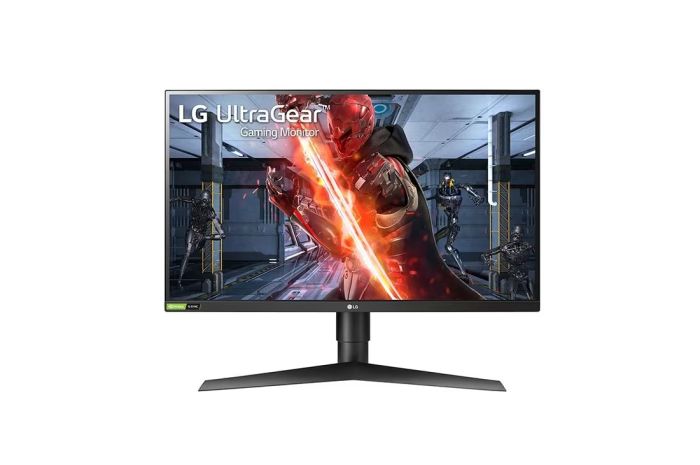LG 27GN750-B.AMA
Those of you following our monitor reviews may be aware of the LG 27GL850, the first of LG's 1ms-class IPS gaming displays and our current favorite 1440p gaming monitor overall. In our review we observed that while that panel couldn't actually hit a 1ms grey to grey average with usable overdrive settings, thanks to LG's improvements to their IPS LCD technology, it was still the fastest 1440p IPS display on the market and a great buy for gamers.
The LG 27GN750 we are reviewing today is a very compelling product, it uses the same 1ms-class IPS technology, but brings it to a new panel type. Instead of going 1440p at 144Hz, the 27GN750 brings a 1ms rated response time to a 27-inch 1080p 240Hz panel. This gives us another option in the high-end 1080p monitor market and one that, thanks to IPS, could be a really convincing buy.
It's not the first 1080p 240Hz IPS monitor we've reviewed though. That goes to the MSI MAG251RX which is a smaller 24-inch design and uses a panel from AU Optronics. And to be honest, it performs really well, easily offering fast enough response times to keep up with the 240Hz refresh rate. So LG has their work cut out for them to offer a great super high refresh experience even with their known quality IPS technology.
Aside from the main specs that we've been talking about, LG offers a fairly typical experience: G-Sync compatibility a.k.a. adaptive sync, so this monitor works with both AMD and Nvidia GPUs. LG also touts HDR10 support, but with no VESA DisplayHDR certification it means it's a worthless inclusion. That's mostly because this is just an sRGB display, 99% according to LG's website but unlike the 27GL850 it doesn't pack in a wide gamut.
The LG 27GN750 is also priced competitively at just $400, which is typical of LG's current monitor line-up. This makes it cheaper than the ViewSonic XG270 and Acer XV273X and around the same price as Asus' attractive VG279QM which we're hoping to review soon.
On the design front, LG is sticking with the same tried and true formula used in the UltraGear line for the last few years. We like it from a visual standpoint, it's not the most premium construction as what you're getting is mostly plastic, but the simplistic black aesthetic with a few red highlights looks fine. Nothing crazy going on here, the focus is purely on that IPS display with decently slim bezels.
There are some neat features included, including height, tilt and pivot support plus very easily accessible ports on the rear. LG doesn't tuck these away behind a plastic flap or along the bottom, they're just straight on the back and easy to access. Two HDMI and a DisplayPort here plus a USB hub and audio output. There are no built-in speakers.
The only real concern is the stand which we found a bit wobbly for our liking, nothing outrageous but the connection between the stand pillar and the legs isn't great, so it does have the opportunity to rock around slightly.
The on-screen display, as with most UltraGear monitors, is controlled through a directional toggle along the bottom edge of the screen. We like LG's OSD layout, it's easy to navigate and has all the relevant information viewable at a glance.
Opinion: 240Hz vs 144Hz
One question that tends to bob up when reviewing high refresh monitors like this is: do you really need 240Hz, and is it an upgrade over 144Hz? Having reviewed a few 240Hz monitors lately, we're becoming more accustomed to the improvements in clarity and motion handling that 240Hz provides over 144Hz, so we'd say there is definitely an improvement. Not as much as the gain from 60 Hz to 144Hz, but playing games on a 240Hz display like this feels extremely responsive and you could even say the same for desktop applications.
In most circumstances you will still need a powerful PC to hit 200+ FPS at 1080p in many titles, so make sure that you have a fast CPU in particular to avoid CPU bottlenecks to get the most out of this sort of monitor.
Something else that should be noted is the pixel density of this monitor. 27-inches of screen real estate but just a 1080p resolution isn't the highest resolution or sharpest experience going around, and we tend to feel 27-inches is slightly too large for a 1080p monitor. It's not bad for gaming, especially when the refresh rate is so high, but for general desktop use like web browsing we feel the pixel density and resolution is a bit of a constraint.
Performance
Now let's take a look at the all important response time information, starting with the four main overdrive modes included. At 240Hz, the off mode does reveal quite decent stock response time numbers for this IPS panel, with a 6.1ms grey to grey average. This is faster than a lot of IPS panels with overdrive, so we're off to a good start.
| GTIN | 719192637511 |
|---|---|
| Color | Black |
| Manufacturer | LG |
| Pixel Pitch | 0.3108mm x 0.3108mm |
| HDMI | Yes (2ea) |
| Warranty | 1 Year |
| Color Gamut | sRGB 95% (CIE1931) |
| Response Time | 1ms (GtG at Faster) |
| Display Port | Yes |
| Contrast Ratio | 1000:1 |
| Resolution | 1920 x 1080 |
| Power Supply | 45W |
| Ports | HDMI Yes (2ea) DisplayPort Yes (1ea) DP Version 1.2 USB Upstream Port Yes (1ea/ver3.0) |













